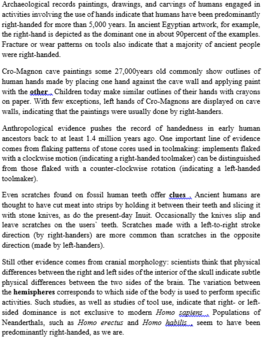Read the following passage and mark the letter A, B, C, or D on your answer sheet to indicate the correct answer to each of the questions from 36 to 42
Leisure activity isn’t just for fun, says a University of Florida psychologist who has developed a scale that classifies hobbies and avocations based on needs they satisfy in people. The scale can help people find more personal fulfillment by giving them insight into what they really like and by helping them to find substitutes when they can’t pursue their favorite activities.
“The surprising thing is that activities you might think are very different have similar effects on people” said Howard E.A. Tinsley, a UF psychology professor who developed the measurement. ―Probably no one would consider acting to have the same characteristics as roller-skating or playing baseball, but men and women who act as a hobby report feeling an intense sense of belonging to a group, much the same way others do in playing sports.
And activities providing the strongest sense of competition are not sports, but card, arcade and computer games, he found.
Tinsley, whose research on leisure has been published in several journals, is scheduled this spring to present some of the findings in Milwaukee at a conference of the Society for Vocational Psychology.
Based on surveys with more than 3,000 people about the satisfactions they get from various hobbies, Tinsley obtained numerical scores for values such as “challenge” and “hedonism”, and grouped some 82 leisure activities into 11 categories. For example, dining out and watching movies fall into the “sensual enjoyment” category, playing soccer and attending sports clubs meetings satisfy participants’ desires for a sense of “belongingness” and coin collecting and baking fulfill their need for “creativity”.
“With so many people in jobs they don’t care for, leisure is a prized aspect of people’s lives,” Tinsley said. “Yet it’s not something psychologists really study. Economists tell us how much money people spend skiing, but nobody explains what it is about skiing that is really appealing to people or how one activity relates to another, perhaps in unexpected ways.”
“Fishing, generally considered more of an outdoor or recreational activity, for example, is a form of self-expression like quilting or stamp collecting, because it gives people the opportunity to express themselves by doing something completely different from their daily routine,”he said.
Which of the following is NOT true?
A. Both acting and roller-skating give people a feeling of being a part of a team
B. Collecting things satisfied people’s desire for making things
C. Fishing allows you to show the type of person you are
D. Researchers already know why a hobby attracts a person








Đáp án D
Câu nào sau đây không đúng?
A. Cả diễn xuất và trượt ba – tanh đều cho con người cảm giác là thành viên của một nhóm B. Sưu tầm các vật dụng làm con người thõa mãn khát vọng làm ra các vật dụng
C. Câu cá cho phép bản thể hiện bản chất con người bạn.
D. Các nhà nghiên cứu đã biết tại 1 sở thích lại thu hút một người.
Dẫn chứng: “but nobody explains what it is about skiing that is really appealing to people or how one activity relates to another, perhaps in unexpected ways.”